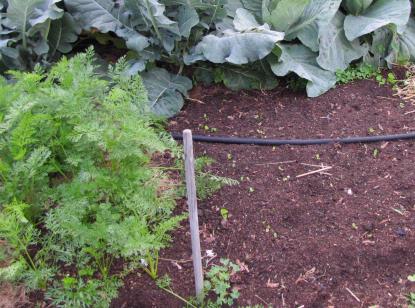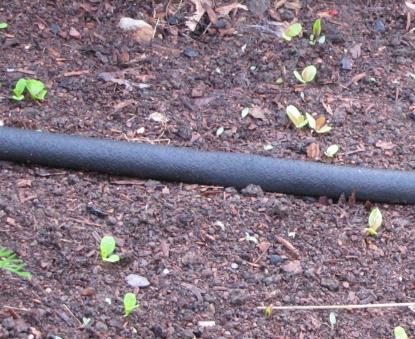My parents have fled far from civilization into northern New Hampshire. This ensures that they will see few people, a prospect which delights them. They mention it a lot when I show up with the children. Their back “yard” is really just a former potato field returning to forest. If they didn’t fervently brush-hog it, they’d soon be enclosed in a deep, dark forest. This reminds me of the weeds encroaching upon my garden, but also the intentional species succession that I try to practice in the garden.
At this point in the season my garden overflows with plant life, though not as of yet with produce. I can’t see any bare soil. This doesn’t stop me from wanting to plant more things. I strive mightily to resist the urge to sneak in a row of beans or carrots close to the still smallish zucchini. Not only do these interloping rows lead to a scattered look, but they tend to produce poorly because of shading and competition from their neighbors.
I get better results if I rely on planned succession planting. Succession planting in the garden is kind of like the way Newt Gingrich handles his wives. Shortly before one becomes “imperfect,” he replaces her. The difference in the garden is that I eat the older produce. I hope Newt’s not reading this.
June is pretty much the first time I have an opportunity to start looking to replace harvested plants. The spinach starts to bolt, we’ve eaten all of the early plantings of lettuce and pretty soon the garlic will be ready for harvest. Now I have an opportunity to plug the holes left as these plantings are rotated out.
Again, I’m tempted. I could squeeze in a few tomato plants or another bunch of butternut squash.
This early in the season, I can still get away with planting cucumbers, corn, or even tomato plants. A few of these, though, would ruin my rotation plans. Instead, I try to go with carrots, beans, lettuce, radishes and beets. We eat lots of them and they don’t belong to one of the big rotation families (except for the beans).
However, later in the summer when the garlic comes out and the peas (what’s left of them) are spent, I do usually put in a big planting of something for the fall. This planting always reminds me of how short our summer is. In July, even though I’m losing half my body weight an hour in sweat, I have to plant cold tolerant plants like cabbage, kale, brussels sprouts, and carrots. Late in the summer, I’ll have to start planting the really cold tolerant stuff like spinach and lettuce to overwinter.
A word of caution: be sure to replenish your soil before re-planting. The plants you’ve harvested or culled are full of nitrogen, phosphorus, potassium and micronutrients. There may be enough left, but probably you’ve depleted something. A nice dollop of compost should help the situation.
When you read one of the big gardening gurus, they often have really elaborate succession schemes. Often they take into account which plants are good “companions.” I find that these can get in the way: don’t let the perfect be the enemy of the good. Instead, put in small easy plants that grow quickly and make you happy — like radishes, chard and bean. These are always a good place to start.


My parents have fled far from civilization into northern New Hampshire. This ensures that they will see few people, a prospect which delights them. They mention it a lot when I show up with the children. Their back “yard” is really just a former potato field returning to forest. If they didn’t fervently brush-hog it, they’d soon be enclosed in a deep, dark forest. This reminds me of the weeds encroaching upon my garden, but also the intentional species succession that I try to practice in the garden.
At this point in the season my garden overflows with plant life, though not as of yet with produce. I can’t see any bare soil. This doesn’t stop me from wanting to plant more things. I strive mightily to resist the urge to sneak in a row of beans or carrots close to the still smallish zucchini. Not only do these interloping rows lead to a scattered look, but they tend to produce poorly because of shading and competition from their neighbors.
I get better results if I rely on planned succession planting. Succession planting in the garden is kind of like the way Newt Gingrich handles his wives. Shortly before one becomes “imperfect,” he replaces her. The difference in the garden is that I eat the older produce. I hope Newt’s not reading this.
June is pretty much the first time I have an opportunity to start looking to replace harvested plants. The spinach starts to bolt, we’ve eaten all of the early plantings of lettuce and pretty soon the garlic will be ready for harvest. Now I have an opportunity to plug the holes left as these plantings are rotated out.
Again, I’m tempted. I could squeeze in a few tomato plants or another bunch of butternut squash.
This early in the season, I can still get away with planting cucumbers, corn, or even tomato plants. A few of these, though, would ruin my rotation plans. Instead, I try to go with carrots, beans, lettuce, radishes and beets. We eat lots of them and they don’t belong to one of the big rotation families (except for the beans).
However, later in the summer when the garlic comes out and the peas (what’s left of them) are spent, I do usually put in a big planting of something for the fall. This planting always reminds me of how short our summer is. In July, even though I’m losing half my body weight an hour in sweat, I have to plant cold tolerant plants like cabbage, kale, brussels sprouts, and carrots. Late in the summer, I’ll have to start planting the really cold tolerant stuff like spinach and lettuce to overwinter.
A word of caution: be sure to replenish your soil before re-planting. The plants you’ve harvested or culled are full of nitrogen, phosphorus, potassium and micronutrients. There may be enough left, but probably you’ve depleted something. A nice dollop of compost should help the situation.
When you read one of the big gardening gurus, they often have really elaborate succession schemes. Often they take into account which plants are good “companions.” I find that these can get in the way: don’t let the perfect be the enemy of the good. Instead, put in small easy plants that grow quickly and make you happy — like radishes, chard and bean. These are always a good place to start.




